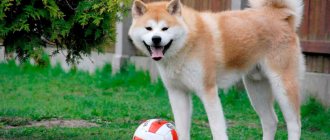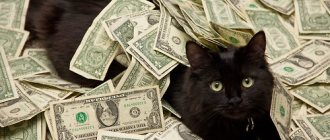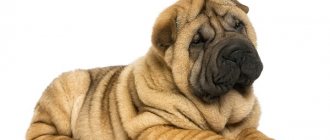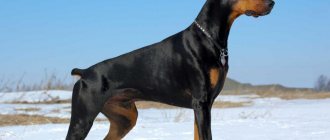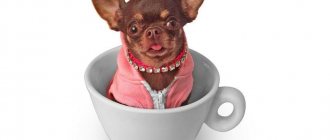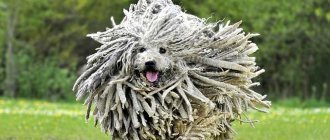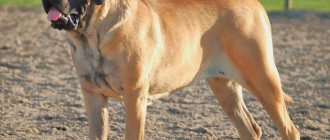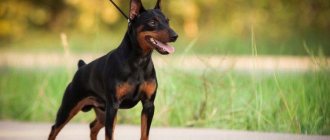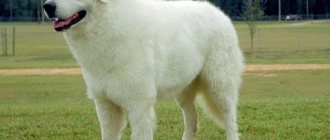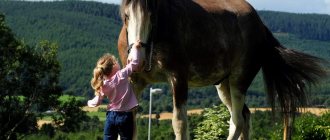The cost of a dog is significantly influenced by exhibition achievements and title. From about 3 months of age, puppies are tested to ensure they meet breed standards. The best individuals are included in the show category, their characteristics are impeccable. Such puppies are either sold at the maximum price or kept for breeding. If such a pet constantly wins competitions, it may be assigned the top show category, and its cost will become sky-high.
So it turns out that a puppy of a common breed, but belonging to the show class, often costs more than a representative of an elite breed, but of the pet category, that is, a simple companion. Therefore, the list is compiled based on average prices for a particular breed.
Pharaoh Hound breed standard
The physique of the “Pharaohs” subtly resembles the Ibicenco Podenco (those same Ibiszo greyhounds), which has given rise to a number of misconceptions regarding both breeds. In reality, dogs from Malta are not relatives of dogs from Ibiza, although both the former and the latter are usually classified as members of the greyhound clan. As for appearance, in this regard the pharaoh dogs have all the trump cards. An elegantly fit silhouette with clearly defined muscles, a graceful elongated head, giving the animal a resemblance to an Egyptian guardian of the underworld, and a fiery iridescent coat color - all together this creates a unique image of a semi-mythical creature that survived the rise and fall of ancient empires.
Sexual dimorphism in the breed is quite pronounced. So, for example, a correct, from the point of view of experts, male Maltese “Pharaoh” should be no lower than 53 cm and no higher than 63.5 cm. For a female, the height limit is 53-61 cm. Separately, it is worth mentioning the running qualities of animals. Pharaoh dogs move in a rapid career, and in order to gain maximum speed, they do not need acceleration. In addition, the breed is distinguished by phenomenal maneuverability, which has helped its representatives successfully hunt small game for thousands of years.
Head
The Pharaoh Hound's skull has a characteristic elongated shape with a moderately pronounced transition from the head to the muzzle.
Jaws and teeth
“Pharaohs” are distinguished by strong teeth and developed jaws, which, when closed, demonstrate a standard scissor bite.
Nose
The skin on the nose is colored pinkish-flesh, in harmony with the coat of the greyhound.
Eyes
A true Pharaoh Hound should have oval, deep-set eyes with brilliant amber colored irises.
Ears
The animal’s large, moderately high-set ears are part of the breed’s “recognition.” When alert, the ear flap assumes a vertical position, giving the dog an even greater resemblance to the Egyptian god Anubis.
Neck
The slightly arched, graceful necks of Pharaoh Hounds are well-lengthened and well-muscled.
Frame
The Pharaoh Hound has an elongated, flexible body with a straight topline, a barely noticeable sloping croup, a deep chest and a harmoniously tucked belly.
Limbs
The legs are straight and parallel to each other. The shoulders are long, strongly laid back, elbows touching the body. The hock angles are moderate and the hips are well developed. The paws of pharaoh dogs are characterized by a flattened shape, toes tightly pressed together and elastic large pads. The animal moves smoothly, with its head held high, without excessively raising its legs in height or throwing its paws to the sides.
Tail
The breed's tail has a whip-like shape and is set not too high, but at the same time not low. When moving, it rises and bends upward. Undesirable transformations: curled tail or pinched between the hind legs.
Wool
The coat of pharaoh dogs has a thin but harsh structure. The hair itself is very short, shiny, and of sufficient thickness. The presence of any fringes is excluded.
Color
The Pharaoh Hound can have a whole range of colors from wheaten-golden to chestnut-red with small white spots. White markings on the tip of the tail, toes, and chest (star) are desirable. A miniature white mark on the muzzle is allowed by the standard, in contrast to specks and white marks on the rest of the body.
Disqualifying faults
Any severe defects in appearance and behavior lead to mandatory disqualification of the animal from competitions. In addition to standard defects such as cowardice, aggression and anatomical developmental anomalies, pharaoh dogs may also exhibit breed-specific “irregularities”. In particular, individuals with a large white spot on the nape are not allowed to participate in exhibitions. Another important point: when taking your dog into the show ring, be prepared for incompetent judging. Such incidents occur from time to time, usually due to the fact that there are very few genuine experts who thoroughly understand the intricacies of the exterior of the “pharaohs”.
Purchasing methods
The main factor in purchasing a Pharaoh Hound is its health and competitive characteristics . Considering the rarity of the breed and its individual body structure, which does not allow it to be confused with any other, the option of buying it “from hand” or at the “bird market” is immediately eliminated.
There are only three nurseries in Russia that breed pharaohs. In addition, the main breeding country for the breed is Malta.
Since the Pharaoh Hound is very stress-resistant, it is quite possible to purchase it from a breeder in another country by preparing all the documents necessary for international transportation of animals and using the services of one of the courier companies.
Main characteristics
| Breed parameters | |
| Country of origin: | Malta |
| Weight of the breed: | males: 24-28 kg, females: 22-26 kg |
| Height at withers: | males: 56-60 cm, females: 48-53 cm |
| Temperament: | active |
| Wool: | short |
| Role in human life: | companion, hunter |
This is one of the most mysterious breeds. Despite the huge number of its fans, there are no more than five thousand individuals all over the world that once belonged to the Egyptian kings. From this article you will learn about the animal's temperament, its habits, diseases and some interesting facts about the breed that make it truly unique.
Pharaoh Hound character
Despite the somewhat pretentious name of the breed, its representatives are completely devoid of arrogance and the desire to suppress everyone and everything. The correct Pharaoh Hound is an affectionate, intelligent and understanding creature with whom it is easy to establish relationships, even without any canine experience. One of the main features of the Maltese rabbit greyhounds is their phenomenal peacefulness. Hyperactive children with their constant running around, narcissistic cats walking around the apartment, crowds of guests - the “pharaoh” perceives such vicissitudes of fate with incredible calm.
However, it is clearly not worth considering a pet as a timid and insecure creature. If necessary, this graceful “model” will bark at a stranger, restrain unruly crows on the street, and protect her own property from children’s attacks. Sociability and curiosity are qualities that every representative of the breed must possess. At the same time, obsession is absolutely alien to pharaoh dogs. Having made sure that the owner is not trying to make contact, the “pharaoh” will not humiliate himself and beg for affection, but will take a break and go about his business.
The innate aristocratic behavior is what sets the Maltese greyhound apart. A real Pharaoh Hound builds behavior depending on the environment and does not allow itself to be superfluous. For example, developing insane speeds in dog racing and chasing a mechanical hare with primitive passion, the “pharaoh” will never turn the apartment in which he lives upside down. Moreover, at home, this fit runner will prefer to play the role of a sofa darling and quietly doze off in a chair while the owner prepares the next portion of goodies for him.
As for living together with other dogs, as well as with their own relatives, here the “Maltese” are surprisingly loyal - this is reflected in their innate lack of conflict. By the way, don't expect the Pharaoh's Hound to be devoted to just one person. Representatives of this breed are distinguished by an even attitude towards all family members, and if they single out someone, they do it very delicately. The graceful “Anubises” do not have such a bad habit as idle nonsense. Usually, the owners who do not like to walk their four-legged charges, and who also have the habit of locking the animal in an empty apartment, complain about the breed’s excessive passion for barking and howling.
Health
Representatives have good immunity and rarely get sick. But some illnesses still happen. These are mostly problems that other purebred dogs face, such as patellar luxation. If your pet doesn't eat properly, it can cause bloating.
Do not allow any chemicals to come into contact with the animal's skin. This may cause allergies. The owner must carefully select care products: shampoos and flea and tick medications.
Pharaohs are sensitive to anesthesia. Because the animals are rather thin, they need a lower dose of the drug than other animals of the same weight. Therefore, before administering anesthesia, the owner should ensure that the veterinarian is aware of this feature.
Pharaoh's hounds are long-lived. Their age can reach 15-17 years with proper care and proper nutrition. Even in old age, these animals are in good shape and behave actively.
Frame
The body is elongated, lean, with developed muscles, the back is almost straight. The limbs are long and strong with pronounced hock joints.
The paws are strong, with tightly pressed toes and hard pads. The tail is whip-shaped, wide at the base, tapering towards the tip. At rest it hangs down to the hocks; at the moment of excitement it rises, taking the shape of a sickle.
Price examples
It is very difficult to find a Pharaoh Hound in Russia. They are bred only in a couple of large regions. In this regard, prices for this breed are very high:
- Moscow region: 50,000-110,000 rubles .
- Nizhny Novgorod region: 35,000-60,000 rubles .
- Republic of Tatarstan: 40,000-70,000 rubles .
- Leningrad region: 60,000-110,000 rubles .
Residents of the Far East will not be able to find a similar breed in their region.
Nutrition
Nutrition issues are of fundamental importance in the maintenance of “pharaohs”. To maintain natural activity, they require a balanced diet with a high content of nutrients. Dogs digest both ready-made dry food and food prepared by the owner equally well.
If the first option is preferred, then it should be premium and super-premium food. In this case, you cannot save money; cheap formulas can undermine your pet’s health.
When preparing your own diet, it must include lean meat (veal, beef, rabbit, liver), cereals, vegetables, and moderately fatty dairy products. You can give your pet a raw egg no more than once a week. It is strictly forbidden to treat your dog to smoked meats, baked goods, sweets, or food containing all kinds of spices.
Maintenance and care
Pharaoh dogs are undemanding to space if they lead an active sporting life outside the home. Modern breeders claim that keeping an “anubis” in an apartment is no more difficult than in a country mansion, if you set the correct daily routine for the animal. Keep in mind that the breed is sensitive to low temperatures (they come from hot Malta, after all), so on frosty days, take the dog for a walk in insulated overalls or force him to spend time actively: run races, play with objects, jump. In general, do whatever helps you stay warm.
Pay due attention to the choice of collar. Due to the elongated neck, not all models are suitable for pharaoh dogs, but only the so-called “herring” - a design that has a wide center and narrowed edges. And please, no harnesses or chains, if you don’t want to choke your pet running after a stray cat. But you don’t have to look for a suitable lounger at all - at home, rabbit greyhounds still prefer to lie on armchairs and sofas, stubbornly ignoring the mattresses bought for them.
Hygiene
In terms of accuracy, pharaoh dogs have no equal. Representatives of this clan always find a way to avoid a dirty puddle and even in the most inclement weather they manage to return from a walk in a neat appearance. Moreover, the Pharaoh Hound is one of those rare image breeds whose representatives do not need to be combed, trimmed or cut. The maximum that is required to maintain the coat in a healthy, presentable form is to walk over it once a week with a rubber mitten.
There is no point in washing “pharaohs” too often, but if the animal gets dirty (which is rather nonsense for the breed), you cannot do without taking a bath. The main thing is to carefully ensure that your pet does not have the opportunity to lick the shampoo, which will negatively affect its digestion. By the way, the “Maltese” themselves have a positive attitude towards water and willingly swim under the supervision of the owner. The eyes of representatives of the breed do not require special care: it is enough to remove dust bunnies in the morning and carry out preventive weekly wiping of the eyelid mucosa with an ophthalmic solution.
The ears of Pharaoh dogs are large and open, so they are well ventilated and do not cause problems for their owners. Of course, it is necessary to inspect the inside of the organ, but usually caring for a greyhound’s ears comes down to removing wax from them with a cotton swab or a damp bandage wrapped around tweezers. By the way, due to the excessively sharp bend of the ear canal, it is undesirable for “pharaohs” to instill liquid preparations and herbal lotions inside, since the animal will not be able to get rid of the liquid on its own. Alternatively, you can use drops in tandem with special veterinary powder. After the liquid has entered the ear and dissolved the wax deposits, it is necessary to dry the inside of the organ by adding a small amount of powder. The powder will absorb excess moisture, and the greyhound will be able to remove it from the ear canal on its own by shaking its head.
Once a month, it is recommended for the Pharaoh Hound to shorten the claw plate so that it does not interfere with running, and twice a week to brush its teeth with veterinary paste and a brush with soft bristles or a bandage wrapped around the finger. If you live in the city and during the cold season you walk with your pet along sidewalks strewn with reagents, take care of the paws of your Maltese rabbit greyhound. In particular, upon returning home, rinse them with warm water and lubricate them with nourishing cream.
Walking and coursing
Ideally, a “pharaoh” should spend about three hours a day outside the home walls. All this time he has the right to give free rein to his instincts - to run, jump and play hard. In case of time pressure, the duration of walks can be reduced to two hours a day, but you will definitely have to go outside with your greyhound in the morning and evening. The optimal alternative to hunting, which few people already practice with Maltese “Anubises,” is coursing. Running after a mechanical hare can both exhaust the animal and reveal its innate talents as a breadwinner.
To awaken interest in chasing a mechanical bait, the puppy is teased with game tied to a rope at an early age. As for full preparation for coursing competitions, it is recommended to start at 7 months of age. At this point, the Pharaoh Hound puppy is relatively strong and has built up the necessary muscle mass. The easiest way to teach proper running is with the help of a bicycle: the owner controls the bike, and the four-legged ward, strapped to the frame, runs alongside. The driving pace should constantly alternate from slow to fast. At the same time, it is important to stop in time - the dog should come from training slightly tired, and not fall from exhaustion.
A good substitute for cycling is racing along snowdrifts, sand dunes and beaches. For such training, it is better to take the animal outside of populated areas, since greyhounds consider car trips as pleasant entertainment. Keep in mind that novices are not allowed on adult tracks immediately. First, growing athletes engage in coursing over short distances, since at the dawn of their sports career, pharaoh hounds should run no more than 100-200 m. In addition, in order to avoid excessive stress, the fragile metacarpus of young individuals who are just beginning to comprehend the basics of coursing are bandaged.
Feeding
The breed is modest in its eating habits. In addition, its representatives have sensitive liver and pancreas, which automatically excludes the consumption of fatty foods. Accordingly, if you prefer to feed your pet “natural” food, rely on lean meat, tripe and offal. By the way, the widespread myth that pharaoh dogs respect plant foods more than animal foods remains a myth. Of course, the diet should include “vegetarian” products, but the basis of the greyhound’s menu, like any dog, is meat and its waste.
An important point: the serving size of Pharaoh Hound is not a constant value. The largest plate should be for individuals participating in coursing and other sporting events. The smallest is among the elderly and “Maltese” who lead a passive lifestyle.
To prevent the dog’s nutrition from costing astronomical sums, it is advisable to mix meat into porridges, for example, buckwheat or rice. In summer, it is useful to feed the animal with fruit and vegetable salads with butter or low-fat sour cream. In winter, the lack of vitamins and fiber will have to be replenished with veterinary complexes, as well as dried algae (kelp, fucus). Low-fat cottage cheese, a chicken egg (no more than once a week), boiled fish fillet are the products necessary for proper nutrition of a greyhound.
Many foreign and domestic pharaoh dog breeders have opted for industrial feed. At the same time, it is important to understand that special savings will not be achieved when switching from “natural” to high-quality “drying”. In order for the animal to feel normal and be energetic in the future, you will have to spend money on super premium and holistic varieties with a high content of animal proteins. It is desirable that the composition of the “drying” includes meat, and not by-products of its processing. For example, some manufacturers use leather, feathers and connective tissues to help increase the amount of protein in dry food. However, such protein will not be absorbed by the “pharaohs” body, and therefore will not be beneficial.
Hygiene
The animal's short coat requires regular brushing with a rubber brush. The molting period (autumn and spring) passes almost unnoticed.
A pleasant feature of this breed is that the wool, even when wet, does not emit a characteristic “dog” smell. The “Pharaoh” should be washed as it gets dirty, but at least once every six months.
Particular attention should be paid to the quality of detergents. These dogs often have allergic reactions to chemicals. For washing, use hypoallergenic puppy shampoos.
Large ears require regular inspection, since during walks small insects and debris can get into them and cause an inflammatory process. If your dog often scratches his ears or rubs them on the floor, this is a reason to consult a veterinarian. As part of regular care, the ears are wiped with a damp swab, and wax deposits are removed as necessary.
After each walk, it is necessary to inspect the paw pads for wounds and abrasions.
Head
The head is elongated, clearly defined, sitting on a muscular neck. The nose is large, pinkish-flesh in color. The eyes are medium-sized, honey-amber in color to match the overall color.
The look is intelligent, lively, interested. Pharaoh Hound puppies are born with blue eyes. By 2.5 months, the iris becomes yellowish, and as it matures it acquires a characteristic amber hue.
A striking breed feature is large, erect ears with pointed tips. They are very active and tend to turn red when the dog is excited or happy. The nose and eye rims also turn red.
And the “pharaohs” know how to wrinkle their noses in a funny way and smile, raising the corners of their lips.
